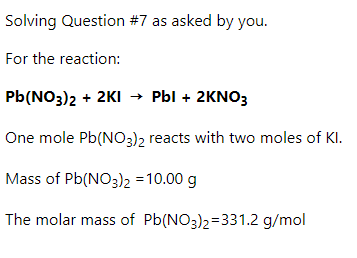Chemistry
10th Edition
ISBN:9781305957404
Author:Steven S. Zumdahl, Susan A. Zumdahl, Donald J. DeCoste
Publisher:Steven S. Zumdahl, Susan A. Zumdahl, Donald J. DeCoste
Chapter1: Chemical Foundations
Section: Chapter Questions
Problem 1RQ: Define and explain the differences between the following terms. a. law and theory b. theory and...
Related questions
Question
#7 show all work
![### Chemistry Problems
#### 6. Dilution and Molarity
**Problem:**
What is the final molarity that would result if you diluted 180.0 mL of a 1.55 M HCl solution to a final volume of 500.0 mL?
**Solution Approach:**
Use the dilution formula:
\[ M_1V_1 = M_2V_2 \]
Where:
- \( M_1 \) = initial molarity
- \( V_1 \) = initial volume
- \( M_2 \) = final molarity
- \( V_2 \) = final volume
#### 7. Reaction Stoichiometry
**Problem:**
Determine the volume of 1.5 M KI solution required for the reaction of 10.00 grams of lead(II) nitrate.
**Reaction:**
\[ \text{Pb(NO}_3\text{)}_2 + 2\text{KI} \rightarrow \text{PbI}_2 + 2\text{KNO}_3 \]
**Solution Approach:**
1. Calculate moles of lead(II) nitrate using its molar mass.
2. Use the stoichiometry of the balanced equation to find moles of KI needed.
3. Use molarity (\( M = \text{moles/volume} \)) to find the required volume of KI solution.
#### 8. Mass from Molarity
**Problem:**
How many grams of KNO\(_3\) are contained in 245 mL of 3.00 M KNO\(_3\) solution?
**Solution Approach:**
1. Convert volume to liters.
2. Use molarity to find moles of KNO\(_3\).
3. Calculate mass using the molar mass of KNO\(_3\).
#### 9. Percent Yield
**Problem:**
If the combustion of 4.00 grams of magnesium results in the actual yield of 5.00 grams of magnesium oxide, what is the percent yield of the reaction?
**Reaction:**
\[ 2\text{Mg(s)} + \text{O}_2\text{(g)} \rightarrow 2\text{MgO(s)} \]
**Solution Approach:**
1. Calculate the theoretical yield of MgO using stoichiometry based on starting mass of magnesium.
2. Use the formula for](/v2/_next/image?url=https%3A%2F%2Fcontent.bartleby.com%2Fqna-images%2Fquestion%2F7cb7ab84-2909-44b4-aa38-afda86b9d9a5%2F6c3a77c1-ad08-4992-8707-86a6794d5bda%2Fiqj3o59_processed.png&w=3840&q=75)
Transcribed Image Text:### Chemistry Problems
#### 6. Dilution and Molarity
**Problem:**
What is the final molarity that would result if you diluted 180.0 mL of a 1.55 M HCl solution to a final volume of 500.0 mL?
**Solution Approach:**
Use the dilution formula:
\[ M_1V_1 = M_2V_2 \]
Where:
- \( M_1 \) = initial molarity
- \( V_1 \) = initial volume
- \( M_2 \) = final molarity
- \( V_2 \) = final volume
#### 7. Reaction Stoichiometry
**Problem:**
Determine the volume of 1.5 M KI solution required for the reaction of 10.00 grams of lead(II) nitrate.
**Reaction:**
\[ \text{Pb(NO}_3\text{)}_2 + 2\text{KI} \rightarrow \text{PbI}_2 + 2\text{KNO}_3 \]
**Solution Approach:**
1. Calculate moles of lead(II) nitrate using its molar mass.
2. Use the stoichiometry of the balanced equation to find moles of KI needed.
3. Use molarity (\( M = \text{moles/volume} \)) to find the required volume of KI solution.
#### 8. Mass from Molarity
**Problem:**
How many grams of KNO\(_3\) are contained in 245 mL of 3.00 M KNO\(_3\) solution?
**Solution Approach:**
1. Convert volume to liters.
2. Use molarity to find moles of KNO\(_3\).
3. Calculate mass using the molar mass of KNO\(_3\).
#### 9. Percent Yield
**Problem:**
If the combustion of 4.00 grams of magnesium results in the actual yield of 5.00 grams of magnesium oxide, what is the percent yield of the reaction?
**Reaction:**
\[ 2\text{Mg(s)} + \text{O}_2\text{(g)} \rightarrow 2\text{MgO(s)} \]
**Solution Approach:**
1. Calculate the theoretical yield of MgO using stoichiometry based on starting mass of magnesium.
2. Use the formula for
Expert Solution
Step 1

Step by step
Solved in 3 steps with 3 images

Knowledge Booster
Learn more about
Need a deep-dive on the concept behind this application? Look no further. Learn more about this topic, chemistry and related others by exploring similar questions and additional content below.Recommended textbooks for you

Chemistry
Chemistry
ISBN:
9781305957404
Author:
Steven S. Zumdahl, Susan A. Zumdahl, Donald J. DeCoste
Publisher:
Cengage Learning

Chemistry
Chemistry
ISBN:
9781259911156
Author:
Raymond Chang Dr., Jason Overby Professor
Publisher:
McGraw-Hill Education

Principles of Instrumental Analysis
Chemistry
ISBN:
9781305577213
Author:
Douglas A. Skoog, F. James Holler, Stanley R. Crouch
Publisher:
Cengage Learning

Chemistry
Chemistry
ISBN:
9781305957404
Author:
Steven S. Zumdahl, Susan A. Zumdahl, Donald J. DeCoste
Publisher:
Cengage Learning

Chemistry
Chemistry
ISBN:
9781259911156
Author:
Raymond Chang Dr., Jason Overby Professor
Publisher:
McGraw-Hill Education

Principles of Instrumental Analysis
Chemistry
ISBN:
9781305577213
Author:
Douglas A. Skoog, F. James Holler, Stanley R. Crouch
Publisher:
Cengage Learning

Organic Chemistry
Chemistry
ISBN:
9780078021558
Author:
Janice Gorzynski Smith Dr.
Publisher:
McGraw-Hill Education

Chemistry: Principles and Reactions
Chemistry
ISBN:
9781305079373
Author:
William L. Masterton, Cecile N. Hurley
Publisher:
Cengage Learning

Elementary Principles of Chemical Processes, Bind…
Chemistry
ISBN:
9781118431221
Author:
Richard M. Felder, Ronald W. Rousseau, Lisa G. Bullard
Publisher:
WILEY